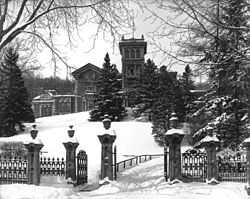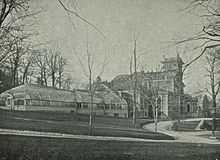Ravenscrag, Montreal
| Ravenscrag | |
|---|---|
 Ravenscrag from Pine Avenue, 1901 | |
| General information | |
| Type | Mansion |
| Architectural style | Italian Renaissance |
| Location | Golden Square Mile |
| Address |
835-1025 Pine Avenue Montreal, Quebec |
| Coordinates | 45°30′21″N 73°34′56″W / 45.5059°N 73.5821°W |
| Construction started | 1860 |
| Completed | 1863 |
| Destroyed | Interior, 1943 |
| Client | Sir Hugh Allan |
| Height | Tower of 75 feet |
| Technical details | |
| Other dimensions | Frontage of 300 feet |
| Floor count | 5 floors, 72 rooms |
| Floor area | 4,968 m2 |
| Design and construction | |
| Architect | John W. Hopkins & Victor Roy |
| Main contractor | William Speirs |
Ravenscrag was a mansion built between 1860 and 1863 in the Golden Square Mile of Montreal, Quebec, for Sir Hugh Allan. In 1940, his son, Sir Montague Allan, donated the property to the Royal Victoria Hospital for use as a medical facility, when its famously sumptuous interior was completely stripped and gutted. Today the building is known as the Allan Memorial Institute and is part of the McGill University Faculty of Medicine. It stands on Pine Avenue at the top of McTavish Street on the slopes of Mount Royal.
On its completion, the mansion of 72 rooms excelled "in size and cost any dwelling-house in Canada," exceeding Dundurn Castle, built by Sir Allan Napier MacNab in 1835.[1] Although reduced in size and lacking its former grandeur, Ravenscrag continues to dominate what remains of the Golden Square Mile today.
Construction


In 1860, Sir Hugh Allan purchased fourteen acres on the slopes of Mount Royal for $10,000 from the estate of the late Simon McTavish, then considered in the countryside, outside the confines of Montreal. He then employed the Liverpool-born architects, Victor Roy and John W. Hopkins of the firm William & Wily, to both design and build him a new home on the land.
By 1863, Hopkins and Roy had completed Allan's home in the style of an Italian Renaissance villa or palazzo, made popular in England since the construction of Osborne House for Queen Victoria and Prince Albert in 1851. Allan named his new home after one of his favourite childhood haunts, the ruins of Ravenscraig Castle, Ayrshire.[2]
As Allan intended, from the outside Ravenscrag was both imposing and intimidating.[3] It had a 300 foot frontage and a Gate Lodge at the end of the drive that now filters out onto Pine Avenue. The view from the house looked over Old Montreal, across the Saint Lawrence River and over to the Green Mountains of Vermont. From the 75 foot tower rising over the house, Allan could occasionally be glimpsed with a brass telescope in hand scanning Longue-Pointe for the safe arrival of the weekly Allan Line Steamer coming in from Glasgow.[4]
Interior
.jpg)
.jpg)
On its completion, Ravenscrag consisted of 72 rooms and covered a vast 4,968 m2 over five floors, including the basement and attic.[5] The reception rooms were built of a size and style compatible for society gatherings and to receive royalty, the first instance of which occurred in 1869 when the Allans entertained the young Prince Arthur during his year in Montreal with the Rifle Brigade.[6]
The interior of the house was a typically eclectic example of Victorian architecture. Bright colours were used, such as the green silk-woven lining on the dining room walls. There were also hand-painted frescos and murals illustrated with mythological or quotidian scenes, and decorative elements were embellished with gilding.[7]
The dining room was in a sedate Georgian-Italian Renaissance style, measuring 60 feet in length and 46 feet across.[8] The Grand Ballroom, with its wrought-iron Minstrels' gallery, was in the style of the French Second Empire and said to have been particularly impressive in both size and decoration.[9] In 1872, the first ball was held at Ravenscrag in honour of the new Governor General of Canada, Lord Dufferin, when the Allans invited 400 guests.[10]
Sir Hugh Allan's favourite room was his library on the ground floor, where he whiled away the hours working, relaxing or playing with his children. The room was typically Victorian and dominated by a wall-to-wall mahogany bookcase, decorated with carved panels depicting sea monsters and mermaids. The piece is one of the very few decorative elements to have survived as it was in Allan's day.[11]
The basement included: two wine cellars, an ice house and a workshop. The main rooms on the ground floor included: the entrance hall, a reception room, a drawing room, a breakfast room, a dining room, a billiard room, a library, two ante-rooms off the Grand Ballroom and a greenhouse containing a vineyard and fruit trees. The East Wing on the ground floor included a pantry, pastry room, summer larder, scullery, dairy, servants hall, butler's room, housekeeper's room and bedrooms for nineteen servants.[12]
The first floor included four main bedrooms, two water closets, two bathrooms, a sitting room, a dressing room and the children's dining room. The second floor included eight bedrooms for the children and one large bathroom. The attic included an observatory. As might have been expected for a house of its kind in Montreal, Ravenscrag was fitted with gas lighting and the most advanced plumbing and heating technology available at the time.[13]
East Wing and Stables
Sir Hugh Allan died the wealthiest man in Canada in 1882, and Ravenscrag was inherited by his second son, Sir Montagu Allan. In 1889, he employed Andrew Taylor to extend the east wing, and he almost doubled the number of servants his father had kept in the house to nineteen. Taylor also enlarged the stables for Sir Montagu in 1898.[14] In 1940, the couple donated Ravenscrag to the Royal Victoria Hospital for use as a medical facility.[15] Its famously lavish interior was entirely gutted and replaced.
Gallery
-
.jpg)
A Ball held at Ravenscrag for Lord Dufferin, 1872
-
.jpg)
Prince Arthur, his equerries and the Allans at the front door of Ravenscrag, 1906
-
.jpg)
Prince Fushimi Hiroyasu at Ravenscrag, 1907
-

Ravenscrag from Pine Avenue, 1913
-

The front entrance door mounted by the Allan crest
-

Allan's family motto : Spero
-

Intertwined Letters "H", "M" and "A" for Hugh Montagu Allan
-

Detail of the vestibule
-
.jpg)
Entrance hall, 1902
-
.jpg)
Reception hall, 1902
-
.jpg)
Reception hall, 1902
-

Fireplace in the reception hall, 1902
-
.jpg)
A corridor leading off from the reception hall, 1913
-
.jpg)
The Ballroom, 1913
-
.jpg)
Dining Room, 1913
-

Library, 1913
-
.jpg)
The stables, 1903
-

Ravenscrag as seen from the east today
-

Gatekeeper's Lodge, as seen today
-

Ravenscrag estate as seen today
References
- ↑ Dictionary of Canadian Biography (1881-1890), Volume XI
- ↑ Biography of Sir Hugh Allan on the Clydesite Magazine, Scotland
- ↑ Archives of the City of Montreal on the Allan Memorial Institute (Royal Victoria Hospital), 2012
- ↑ The Square Mile - Merchant Princes of Montreal (1987); Donald MacKay
- ↑ Robert Bianchini:Ravenscrag, Montréal; McGill University School of Architecture, 1985
- ↑ The Canadian Portrait Gallery, Volume 2: John Charles Dent, 1880
- ↑ François Rémillard: Mansions of the Golden Square Mile, Montreal 1850-1930 - Hugh Allan House. Meridian Press, 1986. Page 55
- ↑ Ravenscrag - Canadian Illustrated News, 1872
- ↑ François Rémillard: Mansions of the Golden Square Mile, Montreal 1850-1930 - Hugh Allan House. Meridian Press, 1986. Page 55
- ↑ François Rémillard: Mansions of the Golden Square Mile, Montreal 1850-1930 - Hugh Allan House. Meridian Press, 1986. Page 55
- ↑ François Rémillard: Mansions of the Golden Square Mile, Montreal 1850-1930 - Hugh Allan House. Meridian Press, 1986. Page 55
- ↑ Julia Gersovitz, Ravenscrag, Montréal, McGill University, School of Architecture, 1975
- ↑ Julia Gersovitz, Ravenscrag, Montréal, McGill University, School of Architecture, 1975
- ↑ http://www.dictionaryofarchitectsincanada.org/architects/view/1349 Biographic Dictionary of Architects in Canada 1800-1950 Andrew Taylor (Architect)
- ↑ Deed of Conveyance (Gift inter vivos), no 488283, 1940-11-19, Me Herbert Bayne McLean (Notary), Registre foncier du Québec en ligne, Ministère des Ressources Naturelles et Faune (consulted october 9, 2013)
See also
| Wikimedia Commons has media related to Ravenscrag, Montreal. |
